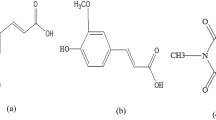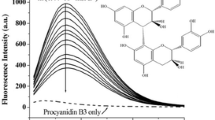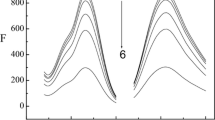Abstract
The quantitative interaction of soybean selenoprotein (SSP) with caffeine (CAF) has been studied by fluorescence, cyclic voltammetry and resonance Rayleigh scattering (RRS) spectra. Fluorescence results demonstrate that the quenching of SSP, induced by CAF, can mainly be attributed to static quenching, and the relative contribution of dynamic quenching is about 0.37% by using a Stem–Volmer analysis. The binding constant (K a) and binding sites (n) of the formed SSP/CAF complex at 293 K calculated from the fluorescence quenching results were found to be 4.29 × 104 L·mol−1 and 1.22, respectively, which is relatively consistent with the corresponding values obtained by cyclic voltammetry. Based on Förster’s theory, the average binding distance (r) between CAF and SSP was found to be 3.03 nm. The interaction mechanism between CAF and SSP was also supported by inspecting the RRS spectra. The effect of CAF on the conformation of SSP was investigated by using the fluorescence phase diagram and circular dichroism spectra. The experimental results show that SSP binding to CAF follows the two-state model and the helical content of SSP decreases after the interaction. In addition, the effect of CAF on the antioxidant activity of SSP was revealed by ultraviolet spectrophotometry. According to the results, SSP/CAF possesses significantly higher antioxidant activity than the control soybean selenoprotein.










Similar content being viewed by others
References
Thavarajah, D., Ruszkowski, J., Vandenberg, A.: High potential for selenium biofortification of lentils. J. Agric. Food Chem. 56, 10747–10753 (2008)
Xiang, T.Y., Wu, Y., Chen, J.Y.: A preliminary approach to biological function of soybean selenoprotein. Acta Nutr. Sin. 26, 460–462 (2004)
Liu, H., Yang, H., Ai, M.X.: Protective effect of soybean selenoprotein on myocardial injuries in diabetic rats. Acta Nutr. Sin. 34, 238–241 (2012)
Svoboda, M., Fajt, Z., Banoch, T., Saláková, A., Drábek, J.: The effects of soybean selenium proteinate on tissue selenium and meat quality traits in finishing pigs. Pol. J. Vet. Sci. 14, 147–148 (2011)
Hatfield, D.L., Tsuji, P.A., Carlson, B.A.: Selenium and selenocysteine: roles in cancer, health, and development. Trends Biochem. Sci. 39, 112–120 (2014)
Hu, J.U., Zhao, Q., Cheng, X., Selomulya, C., Bai, C.Q., Zhu, X.M., Li, X.H., Xiong, H.: Antioxidant activities of Se-SPI produced from soybean as accumulation and biotransformation reactor of natural selenium. Food Chem. 146, 531–537 (2014)
Cui, L.J., Qu, L.L., Yang, W.Y., Dou, Y.H., Jiao, N., Huang, Y.: Spectroscopic studies on the interaction of rutin and lysozyme. Mod. Food Sci. Technol. 30, 30–35 (2014)
Hu, Y., Wu, X.Y., Zhong, N.J., Xu, J.R.: Study on the conformation of soybean selenoprotein solution with spectroscopy methods. Spetcrosc. Spect. Anal. 36, 2874–2878 (2016)
Hartley, T.R., Lovallo, W.R., Whitsett, T.L.: Cardiovascular effects of caffeine in men and women. Am. J. Cardiol. 93, 1022–1026 (2004)
Ramanaviciene, A., Acaite, J., Ramanavicius, A.: Chronic caffeine intake affects lysozyme activity and immune cells in mice. J. Pharm. Pharmacol. 56, 671–676 (2004)
Karahan, M., Mustafaeva, Z., Özeroğlu, C.: Investigation of ternary complex formations of polyacrylic acid with bovine serum albumin in the presence of metal ions by fluorescence and dynamic light scattering measurements. Protein J. 29, 336–342 (2010)
Weert, M.V.D., Stella, L.: Fluorescence quenching and ligand binding: a critical discussion of a popular methodology. J. Mol. Struct. 998, 144–150 (2011)
Wang, R.Q., Li, Z.G., Yang, L.L., Ren, T., Zhang, L.J., Wang, R.Y.: Studies on the interaction between neutral red and bovine hemoglobin by fluorescence spectroscopy and molecular modeling. J. Mol. Liq. 211, 584–590 (2015)
Song, S.M., Wang, Y.X., Xiong, L.M., Qu, L.B., Xu, M.T.: Interaction between baicalein and amyloid-β fibrils studied by fluorescence spectroscopy. Chem. Res. Chin. Univ. 29, 20–25 (2013)
Lei, H.T., Tang, Q.S., Huang, W.K., Situ, C., Liu, Y.J., Sun, Y.M.: Fluorescence spectra study on specific and non-specific interactions between chrysoidine and proteins. Chin. J. Anal. Chem. 40, 1231–1235 (2012)
Backhus, D.A., Golini, C., Castellanos, E.: Evaluation of fluorescence quenching for assessing the importance of interactions between nonpolar organic pollutants and dissolved organic matter. Environ. Sci. Technol. 37, 4717–4723 (2003)
Qin, Y., Zhang, Y., Yan, S., Ye, L.: A comparison study on the interaction of hyperoside and bovine serum albumin with Tachiya model and Stern–Volmer equation. Spectrochim. Acta A 75, 1506–1510 (2010)
Gowda, J.I., Nandibewoor, S.T.: Binding and conformational changes of human serum albumin upon interaction with 4-aminoantipyrine studied by spectroscopic methods and cyclic voltammetry. Spectrochim. Acta A 124, 397–403 (2014)
Ghosh, K., Rathi, S., Arora, D.: Fluorescence spectral studies on interaction of fluorescent probes with bovine serum albumin. J. Lumin. 175, 135–140 (2016)
Zhang, W.Z., Chen, X.D., Yang, J., Luo, W.A., Zhang, M.Q.: Quantitative description of aggregation and dissociation of polystyrene chains in cyclohexane solutions by resonance light scattering technique. J. Phys. Chem. B. 114, 1301–1306 (2010)
Weert, M.V.D.: Fluorescence quenching to study protein–ligand binding: common errors. J. Fluoresc. 20, 625–629 (2010)
Sun, W., Han, J.Y., Ren, Y., Jiao, K.: Voltammetric studies on the interaction of orange G with proteins. J. Braz. Chem. Soc. 17, 510–517 (2006)
Gawhale, S., Thakare, Y., Malkhede, D.: Study on complex formation of fluorescein-p-sulfonatocalix[4]arene by spectroscopic methods. Opt. Photonics J. 4, 237–245 (2014)
Peng, X., Sun, Y.N., Qi, W., Su, R.X., He, Z.M.: Study of the interaction between coenzyme Q10 and human serum albumin: spectroscopic approach. J. Solution Chem. 43, 585–607 (2014)
Xiao, J.B., Zhao, Y.R., Wang, H., Yuan, Y.M., Yang, F., Zhang, C., Yamatoto, K.: Noncovalent interaction of dietary polyphenols with common human plasma proteins. J. Agric. Food Chem. 59, 10747–10754 (2011)
Purcell, M., Neault, J.F., Malonga, H., Arakawa, H., Carpentier, R., Tajmir-Riahi, H.A.: Interactions of atrazine and 2,4-D with human serum albumin studied by gel and capillary electrophoresis, and FTIR spectroscopy. Biochim. Biophys. Acta 1548, 129–138 (2001)
Zhu, G.F., Wang, Y., Xi, L., Liu, J., Wang, H., Du, L.F.: Spectroscopy and molecular docking studies on the binding of propyl gallate to human serum albumin. J. Lumin. 159, 188–196 (2015)
Zhang, T., Bian, L.J.: Distribution and transition of stable conformations of hen egg white lysozymes in their unfolding induced by urea and guanidine hydrochloride solutions. Chem. Res. Chin. Univ. 32, 1497–1505 (2011)
Mitic, V., Jovanovic, V.S., Dimitrijevic, M., Cvetkovic, J., Stojanovic, G.: Effect of food preparation technique on antioxidant activity and plant pigment content in some vegetable species. J. Food. Nutr. Res. 1, 121–127 (2013)
Li, C.P., He, Z., Wang, X.Y., Yang, L., Yin, C.Y., Zhang, N., Lin, J., Hui Zhao, H.: Selenization of ovalbumin by dry-heating in the presence of selenite: effect on protein structure and antioxidant activity. Food Chem. 148, 209–217 (2014)
Acknowledgements
This research was supported by the Research Foundation of Education Bureau of Guangdong Province, China (Grant No. 2015KTSCX072) and the Guangdong Pharmaceutical University Fundament “Project of Innovation for Enhancing College” (Grant No. 2015cxqx156).
Author information
Authors and Affiliations
Corresponding author
Rights and permissions
About this article
Cite this article
Hu, Y., Guo, J. & Xu, J. Characterization of the Interaction Between Caffeine and Soybean Selenoprotein by Spectroscopic and Cyclic Voltammetric Methods. J Solution Chem 46, 2293–2305 (2017). https://doi.org/10.1007/s10953-017-0697-5
Received:
Accepted:
Published:
Issue Date:
DOI: https://doi.org/10.1007/s10953-017-0697-5




